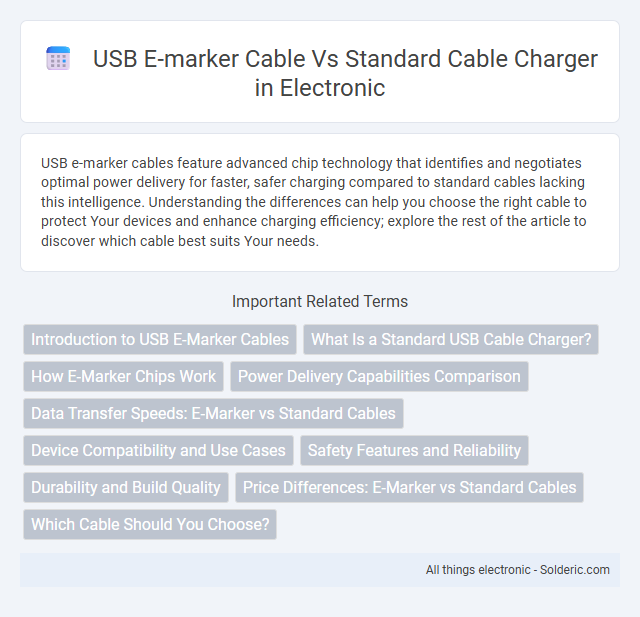USB e-marker cables feature advanced chip technology that identifies and negotiates optimal power delivery for faster, safer charging compared to standard cables lacking this intelligence. Understanding the differences can help you choose the right cable to protect Your devices and enhance charging efficiency; explore the rest of the article to discover which cable best suits Your needs.
Comparison Table
| Feature | USB E-Marker Cable | Standard Cable Charger |
|---|---|---|
| Data Transfer Rate | Up to 40 Gbps (USB4/Thunderbolt) | Up to 5 Gbps (USB 3.0) or lower |
| Power Delivery | Supports up to 100W (20V/5A) | Typically up to 60W or lower |
| Chip Presence | Includes E-Marker chip for communication | No E-Marker chip |
| Safety | Enhanced safety with power negotiation | Basic safety, no power negotiation |
| Compatibility | Compatible with USB PD standards and devices | Limited compatibility for high power devices |
| Cable Thickness | Thicker gauge for high current | Thinner gauge, limits power capacity |
| Cost | Higher cost due to components | Lower cost, simple design |
Introduction to USB E-Marker Cables
USB E-Marker cables feature embedded chips that communicate the cable's capabilities, such as power delivery and data transfer rates, ensuring optimal performance and safety for your devices. Unlike standard cables, E-Marker cables support higher current levels up to 5A and voltage up to 20V, enabling faster charging and enhanced compatibility with USB-C Power Delivery standards. Choosing a USB E-Marker cable guarantees reliable operation with advanced devices, reducing the risk of overheating and maximizing charging efficiency.
What Is a Standard USB Cable Charger?
A standard USB cable charger transfers power and data without advanced features like power negotiation or enhanced safety protocols found in USB e-marker cables. Unlike e-marker cables, standard USB cables typically support lower current levels, limiting charging speed and device compatibility. Your choice impacts charging efficiency and device protection, making e-marker cables essential for high-power fast charging scenarios.
How E-Marker Chips Work
E-Marker chips embedded in USB cables communicate with devices to identify supported power levels and data transfer rates, enabling safer and faster charging compared to standard cables. These chips regulate voltage and current by negotiating between your charger and device, preventing overheating and enhancing compatibility with high-wattage USB Power Delivery protocols. Using a USB e-marker cable ensures optimal charging efficiency and protects your electronics by managing the precise electrical parameters during the charging process.
Power Delivery Capabilities Comparison
USB E-marker cables support higher power delivery capabilities, enabling fast charging up to 100W by accurately communicating current and voltage levels between devices and chargers. Standard USB cables typically handle lower power limits, often maxing out at 60W or less, lacking the embedded chip necessary for negotiable power delivery. The presence of an E-marker ensures optimized charging efficiency and safety by preventing overcurrent or overheating during high-power transfer.
Data Transfer Speeds: E-Marker vs Standard Cables
USB e-marker cables support higher data transfer speeds up to 40 Gbps with USB4 or Thunderbolt 3 standards, while standard cables typically max out at 480 Mbps with USB 2.0 or 5 Gbps with USB 3.0. This difference is due to e-marker chips embedded in the cables that communicate supported speeds and power delivery capabilities between devices. Choosing an e-marker cable improves your data transfer efficiency, especially for large files or high-resolution video streaming.
Device Compatibility and Use Cases
USB e-marker cables feature embedded chips that communicate power and data capabilities, ensuring optimal device compatibility with high-power chargers and fast-charging protocols like USB Power Delivery. Standard cables lack this intelligence, limiting their use to basic charging and data transfer, often resulting in slower charging speeds or incompatibility with newer devices requiring precise power negotiation. Using an e-marker cable enhances your charging experience by supporting a wider range of devices, including laptops, smartphones, and tablets, while providing safe and efficient power delivery.
Safety Features and Reliability
USB e-marker cables incorporate integrated chips that communicate power requirements and authentications between devices, ensuring enhanced safety by preventing overcurrent, overheating, and voltage mismatches. Standard cables lack this intelligence, increasing risks of damage to both chargers and devices due to improper power delivery. Your charging experience becomes more reliable and secure with e-marker cables, as they adhere to USB Power Delivery specifications and protect against potential hazards.
Durability and Build Quality
USB e-marker cables feature enhanced durability and superior build quality due to integrated electronic markers that regulate power delivery and data transfer, reducing overheating and wear. These cables often use thicker, high-grade materials and reinforced connectors designed to withstand frequent use and bending, extending your charging cable's lifespan. Standard cable chargers typically lack these advanced protections, making them more susceptible to damage and reduced performance over time.
Price Differences: E-Marker vs Standard Cables
USB E-marker cables typically cost more than standard cables due to the integrated chip that manages power delivery and ensures safety during high-wattage charging. These cables support faster charging speeds and compatibility with various devices, justifying the higher price for users who need reliable and efficient power transfer. Investing in an E-marker cable improves your device's charging performance and prevents potential damage caused by improper power regulation.
Which Cable Should You Choose?
Choosing a USB E-marker cable over a standard cable charger is essential when fast charging or high-power delivery is required, as E-marker cables can support up to 100W of power and provide optimal data transfer speeds. Standard cables often lack the intelligence to communicate proper power levels, leading to slower charging and potential device damage. For reliable performance with high-end laptops or smartphones utilizing USB Power Delivery (PD) 3.0, an E-marker cable ensures safety, efficiency, and maximum compatibility.
USB e-marker cable vs standard cable charger Infographic

 solderic.com
solderic.com